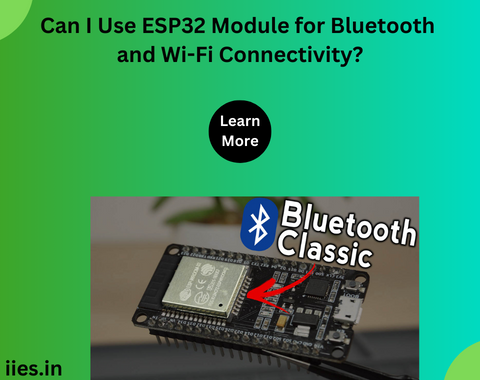
In the rapidly evolving landscape of IoT (Internet of Things), connectivity is the backbone of innovation. One remarkable player in this realm is the ESP32 module, renowned for its exceptional capabilities in providing both Bluetooth and Wi-Fi connectivity. This article aims to delve into the intricacies of utilizing the ESP32 for these dual functionalities and explores its applications in various domains.
The ESP32, developed by Espressif Systems, is a powerful and versatile microcontroller that has gained immense popularity in the IoT community
One of the standout features of ESP32 is its built-in Bluetooth functionality. The module supports both Classic Bluetooth and Bluetooth Low Energy (BLE), expanding its compatibility with a wide range of devices.
1. Classic Bluetooth (BT):
Classic Bluetooth enables the ESP32 to connect with devices like smartphones, laptops, and other peripherals over short distances. This makes the ESP32 suitable for applications such as wireless audio streaming, remote control systems, and data transfer between devices.
2. Bluetooth Low Energy (BLE):
BLE is a power-efficient variant of Bluetooth, making it well-suited for IoT applications with low-power requirements. ESP32’s BLE capabilities open the door to a myriad of possibilities, including wearable devices, health monitors, and proximity-based applications.
Wi-Fi Connectivity with ESP32:
In addition to Bluetooth, the ESP32 comes with integrated Wi-Fi capabilities, making it a robust choice for projects demanding internet connectivity.
1. Station Mode:
In Station mode, the ESP32 can connect to an existing Wi-Fi network, enabling it to access the internet and communicate with other devices on the network. This mode is ideal for applications such as home automation, smart agriculture, and industrial monitoring.
2. Soft Access Point (SoftAP) Mode:
The ESP32 can also function as a Wi-Fi access point, allowing other devices to connect to it. This mode is useful in scenarios where creating a local network is necessary, like in peer-to-peer communication or setting up temporary networks at events.
3. Wi-Fi Direct:
Wi-Fi Direct enables two ESP32 modules to establish a direct connection without the need for a traditional Wi-Fi network. This feature is valuable for applications like file sharing, gaming, and collaborative projects where a direct, device-to-device connection is preferred.
Combining Bluetooth and Wi-Fi:
The ESP32’s ability to concurrently support Bluetooth and Wi-Fi connectivity is a game-changer. This simultaneous support opens up possibilities for creating complex IoT ecosystems that require communication between devices using both technologies.
1. Example Applications:
– Smart Home Systems: ESP32 can act as a central hub connecting various smart devices using both Wi-Fi and Bluetooth, allowing users to control and monitor their smart home seamlessly.
– Healthcare Wearables: The combination of Wi-Fi for data upload and Bluetooth for local connectivity is advantageous in healthcare wearables, ensuring constant monitoring while conserving power.
2. Development Challenges:
– Coexistence: Ensuring smooth coexistence between Wi-Fi and Bluetooth signals can be challenging. Careful consideration and optimization of communication protocols are necessary to avoid interference.
– Power Consumption: Balancing the power requirements of both Bluetooth and Wi-Fi can be crucial, especially in battery-powered IoT devices. Developers need to implement power-saving strategies to maximize the device’s operational lifespan.
Programming ESP32 for Connectivity:
To harness the full potential of ESP32’s dual connectivity features, a thorough understanding of its programming environment is essential. Arduino IDE and MicroPython are popular choices for programming ESP32 modules, offering a user-friendly interface and extensive libraries for Bluetooth and Wi-Fi functionalities.
1. Arduino IDE:
– Arduino IDE provides a simplified programming environment for ESP32, allowing developers to write code using the Arduino programming language. Various libraries are available for Bluetooth and Wi-Fi, making it easier to implement complex functionalities.
2. MicroPython:
– MicroPython is a lightweight and efficient implementation of the Python 3 programming language tailored for microcontrollers. It provides a high-level interface for ESP32, simplifying the development process while maintaining the flexibility and power of Python.
Expanding the Horizon: Advanced Features and Real-world Applications of ESP32
Beyond its fundamental Bluetooth and Wi-Fi capabilities, the ESP32 boasts advanced features that enhance its versatility and make it a favorite among developers tackling diverse projects.
Dual-Core Processing:
The ESP32’s dual-core processor architecture is a standout feature that enables multitasking and improved performance. This allows developers to dedicate one core to handle Wi-Fi connectivity while the other manages Bluetooth operations, enhancing the overall efficiency of the system.
Secure Wi-Fi Connections:
Security is a paramount concern in IoT applications. ESP32 supports WPA3, the latest Wi-Fi security protocol, providing robust protection against unauthorized access and ensuring the confidentiality of data transmissions. This makes it an excellent choice for applications where data privacy is non-negotiable.
Web Server Capabilities:
The ESP32 can function as a web server, opening up possibilities for remote monitoring and control. This feature is particularly beneficial in projects where users need to access and manage devices over the internet, such as smart home applications or industrial automation systems.
OTA (Over-The-Air) Updates:
ESP32 simplifies the process of updating firmware with its OTA update feature. This allows developers to remotely update the device’s software, eliminating the need for physical access to the device. OTA updates are crucial for maintaining security and adding new features without disrupting the device’s operation.
The ESP32’s seamless integration of Bluetooth and Wi-Fi connectivity makes it a standout choice for IoT enthusiasts and professionals alike. Its versatility allows for the development of a wide array of applications, ranging from simple home automation projects to complex industrial systems. As technology continues to advance, the ESP32 remains a beacon in the world of connectivity, paving the way for innovative solutions in the IoT landscape. Whether you are a hobbyist or a seasoned developer, the ESP32 stands ready to empower your projects with reliable and efficient wireless communication.
Indian Institute of Embedded Systems – IIES